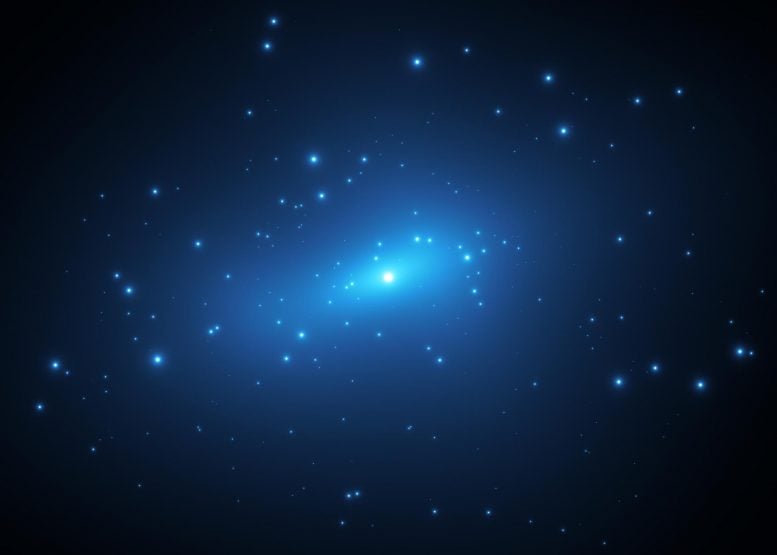
This artist’s impression represents small-scale concentrations of dark matter in the galaxy cluster MACSJ 1206. Astronomers measured the amount of gravitational lensing caused by this cluster to produce a detailed map of the distribution of dark matter in it. Dark matter is the invisible glue that keeps stars bound together inside a galaxy and makes up the bulk of the matter in the Universe. Credit: ESA/Hubble, M. Kornmesser
Observations by the NASA/ESA Hubble Space Telescope and the European Southern Observatory’s Very Large Telescope (VLT) in Chile have found that something may be missing from the theories of how dark matter behaves. This missing ingredient may explain why researchers have uncovered an unexpected discrepancy between observations of the dark matter concentrations in a sample of massive galaxy clusters and theoretical computer simulations of how dark matter should be distributed in clusters. The new findings indicate that some small-scale concentrations of dark matter produce lensing effects that are 10 times stronger than expected.
Dark matter is the invisible glue that keeps stars, dust, and gas together in a galaxy. This mysterious substance makes up the bulk of a galaxy’s mass and forms the foundation of our Universe’s large-scale structure. Because dark matter does not emit, absorb, or reflect light, its presence is only known through its gravitational pull on visible matter in space. Astronomers and physicists are still trying to pin down what it is.
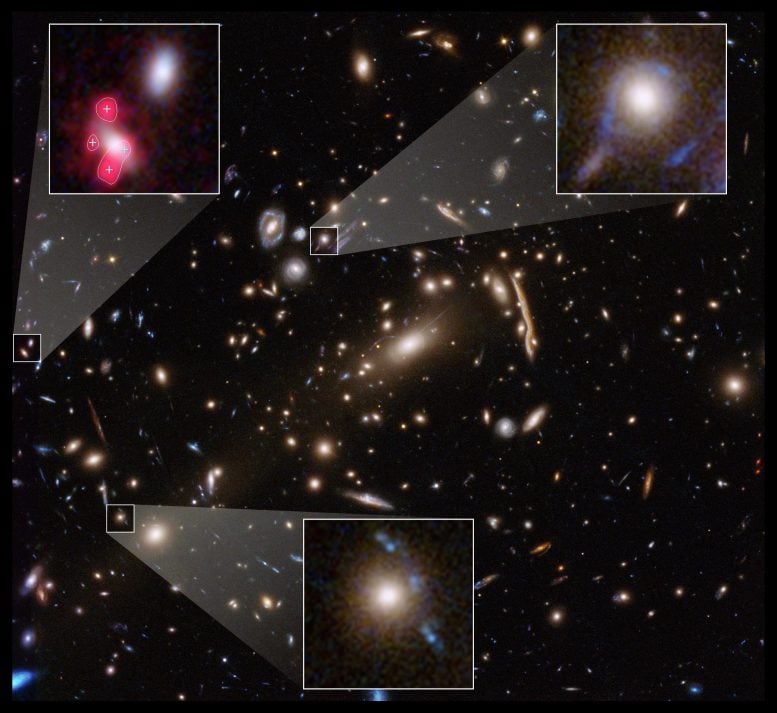
This Hubble Space Telescope image shows the massive galaxy cluster MACSJ 1206. Embedded within the cluster are the distorted images of distant background galaxies, seen as arcs and smeared features. These distortions are caused by the dark matter in the cluster, whose gravity bends and magnifies the light from faraway galaxies, an effect called gravitational lensing. This phenomenon allows astronomers to study remote galaxies that would otherwise be too faint to see.
Astronomers measured the amount of gravitational lensing caused by this cluster to produce a detailed map of the distribution of dark matter in it. Dark matter is the invisible glue that keeps stars bound together inside a galaxy and makes up the bulk of the matter in the Universe.
The Hubble image is a combination of visible- and infrared-light observations taken in 2011 by the Advanced Camera for Surveys and Wide Field Camera 3.
Credit: NASA, ESA, G. Caminha (University of Groningen), M. Meneghetti (Observatory of Astrophysics and Space Science of Bologna), P. Natarajan (Yale University), and the CLASH team.
Galaxy clusters, the most massive and recently assembled structures in the Universe, are also the largest repositories of dark matter. Clusters are composed of individual member galaxies that are held together largely by the gravity of dark matter.
“Galaxy clusters are ideal laboratories in which to study whether the numerical simulations of the Universe that are currently available reproduce well what we can infer from gravitational lensing,” said Massimo Meneghetti of the INAF-Observatory of Astrophysics and Space Science of Bologna in Italy, the study’s lead author.
This video begins with an image from the NASA/ESA Hubble Space Telescope of the massive galaxy cluster MACSJ 1206. Embedded within the cluster are the distorted images of distant background galaxies, seen as arcs and smeared features. These distortions are caused by the dark matter in the cluster, whose gravity bends and magnifies the light from faraway galaxies, an effect called gravitational lensing. This phenomenon allows astronomers to study remote galaxies that would otherwise be too faint to see.
The video then shows an artist’s impression of small-scale concentrations of dark matter (represented in this video in blue). Dark matter is the invisible glue that keeps stars bound together inside a galaxy and makes up the bulk of the matter in the Universe. These blue halos reflect how the galaxy cluster’s dark matter is distributed, revealed by new results from the Hubble Space Telescope. This was accomplished by a team of astronomers by measuring the amount of gravitational lensing.
Credit: NASA, ESA, G. Caminha (University of Groningen), M. Meneghetti (Observatory of Astrophysics and Space Science of Bologna), P. Natarajan (Yale University), the CLASH team, and M. Kornmesser (ESA/Hubble)
“We have done a lot of testing of the data in this study, and we are sure that this mismatch indicates that some physical ingredient is missing either from the simulations or from our understanding of the nature of dark matter,” added Meneghetti.
“There’s a feature of the real Universe that we are simply not capturing in our current theoretical models,” added Priyamvada Natarajan of Yale University in Connecticut, USA, one of the senior theorists on the team. “This could signal a gap in our current understanding of the nature of dark matter and its properties, as these exquisite data have permitted us to probe the detailed distribution of dark matter on the smallest scales.”
This video shows an artist’s impression of the phenomenon of gravitational lensing.
Credit: ESA/Hubble and M. Kornmesser
The distribution of dark matter in clusters is mapped by measuring the bending of light — the gravitational lensing effect — that they produce. The gravity of dark matter concentrated in clusters magnifies and warps light from distant background objects. This effect produces distortions in the shapes of background galaxies which appear in images of the clusters. Gravitational lensing can often also produce multiple images of the same distant galaxy.
The higher the concentration of dark matter in a cluster, the more dramatic its light-bending effect. The presence of smaller-scale clumps of dark matter associated with individual cluster galaxies enhances the level of distortions. In some sense, the galaxy cluster acts as a large-scale lens that has many smaller lenses embedded within it.
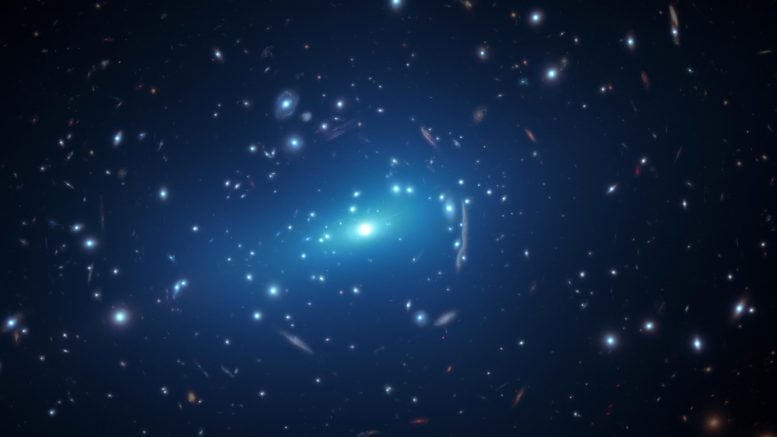
This NASA/ESA Hubble Space Telescope image shows the massive galaxy cluster MACSJ 1206. Embedded within the cluster are the distorted images of distant background galaxies, seen as arcs and smeared features. These distortions are caused by the dark matter in the cluster, whose gravity bends and magnifies the light from faraway galaxies, an effect called gravitational lensing. This phenomenon allows astronomers to study remote galaxies that would otherwise be too faint to see.
Overlaid on the image are small-scale concentrations of dark matter (represented in this artist’s impression in blue). Dark matter is the invisible glue that keeps stars bound together inside a galaxy and makes up the bulk of the matter in the Universe. These blue halos reflect how the galaxy cluster’s dark matter is distributed, revealed by new results from the Hubble Space Telescope. This was accomplished by a team of astronomers by measuring the amount of gravitational lensing.
Credit: NASA, ESA, G. Caminha (University of Groningen), M. Meneghetti (Observatory of Astrophysics and Space Science of Bologna), P. Natarajan (Yale University), the CLASH team, and M. Kornmesser (ESA/Hubble)
Hubble’s crisp images were taken by the telescope’s Wide Field Camera 3 and Advanced Camera for Surveys. Coupled with spectra from the European Southern Observatory’s Very Large Telescope (VLT), the team produced an accurate, high-fidelity, dark-matter map. By measuring the lensing distortions astronomers could trace out the amount and distribution of dark matter. The three key galaxy clusters, MACS J1206.2-0847, MACS J0416.1-2403, and Abell S1063, were part of two Hubble surveys: The Frontier Fields and the Cluster Lensing And Supernova survey with Hubble (CLASH) programs.
To the team’s surprise, in addition to the dramatic arcs and elongated features of distant galaxies produced by each cluster’s gravitational lensing, the Hubble images also revealed an unexpected number of smaller-scale arcs and distorted images nested near each cluster’s core, where the most massive galaxies reside. The researchers believe the nested lenses are produced by the gravity of dense concentrations of matter inside the individual cluster galaxies. Follow-up spectroscopic observations measured the velocity of the stars orbiting inside several of the cluster galaxies to thereby pin down their masses.
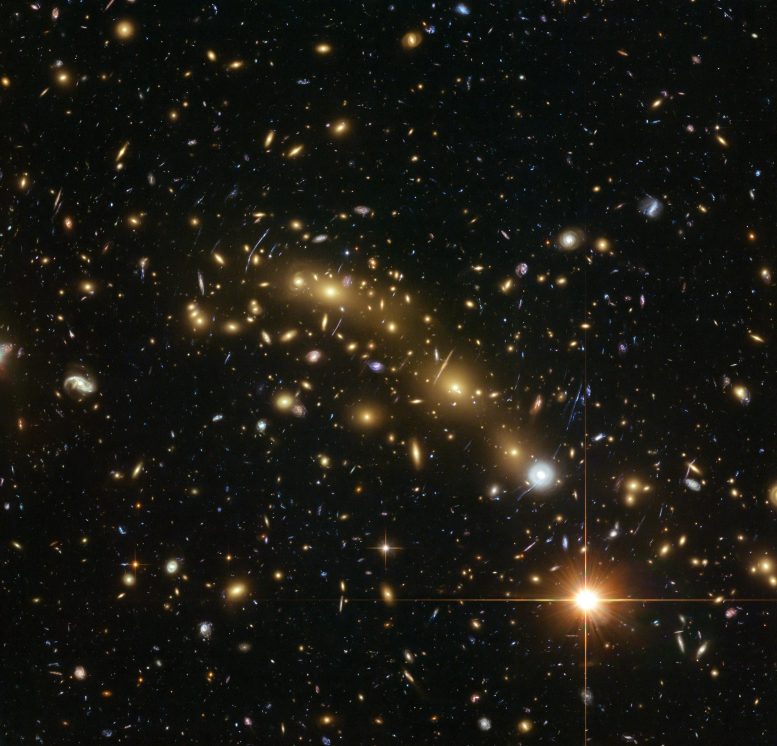
This image from the NASA/ESA Hubble Space Telescope shows the galaxy cluster MACS J0416.1–2403. This is one of six being studied by the Hubble Frontier Fields program. This program seeks to analyze the mass distribution in these huge clusters and to use the gravitational lensing effect of these clusters, to peer even deeper into the distant Universe.
A team of researchers used almost 200 images of distant galaxies, whose light has been bent and magnified by this huge cluster, combined with the depth of Hubble data to measure the total mass of this cluster more precisely than ever before.
Credit: ESA/Hubble, NASA, HST Frontier Fields Acknowledgement: Mathilde Jauzac (Durham University, UK and Astrophysics & Cosmology Research Unit, South Africa) and Jean-Paul Kneib (École Polytechnique Fédérale de Lausanne, Switzerland)
“The data from Hubble and the VLT provided excellent synergy,” shared team member Piero Rosati of the Università degli Studi di Ferrara in Italy, who led the spectroscopic campaign. “We were able to associate the galaxies with each cluster and estimate their distances.”
“The speed of the stars gave us an estimate of each individual galaxy’s mass, including the amount of dark matter,” added team member Pietro Bergamini of the INAF-Observatory of Astrophysics and Space Science in Bologna, Italy.
By combining Hubble imaging and VLT spectroscopy, the astronomers were able to identify dozens of multiply imaged, lensed, background galaxies. This allowed them to assemble a well-calibrated, high-resolution map of the mass distribution of dark matter in each cluster.
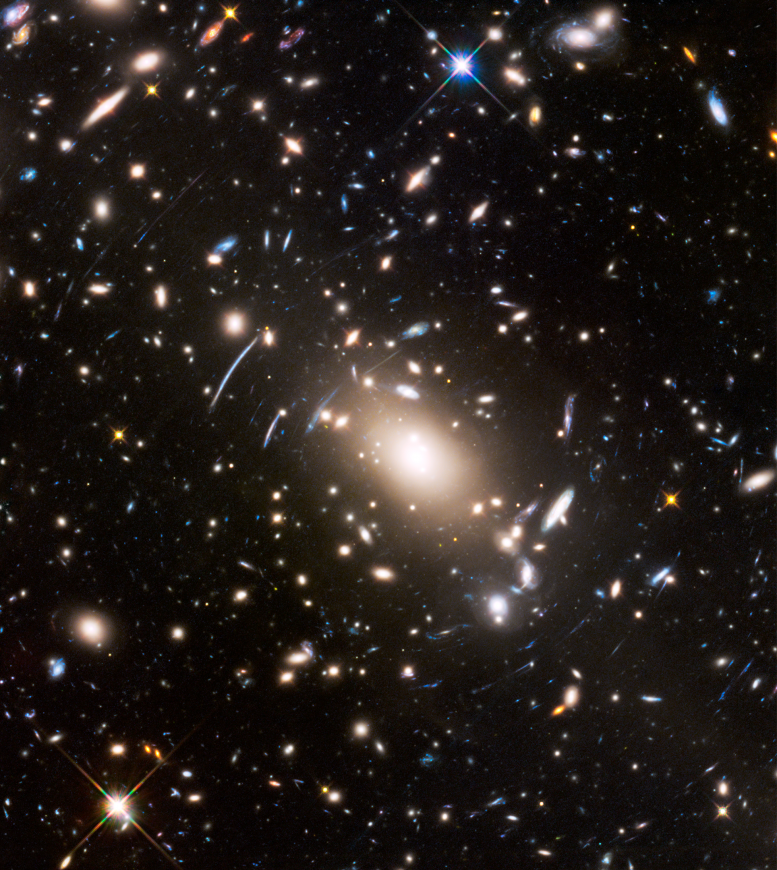
Abell S1063, a galaxy cluster, was observed by the NASA/ESA Hubble Space Telescope as part of the Frontier Fields program. The huge mass of the cluster acts as a cosmic magnifying glass and enlarges even more distant galaxies, so they become bright enough for Hubble to see. Credit: NASA, ESA, and J. Lotz (STScI)
The team compared the dark-matter maps with samples of simulated galaxy clusters with similar masses, located at roughly the same distances. The clusters in the computer model did not show any of the same level of dark-matter concentration on the smallest scales — the scales associated with individual cluster galaxies.
“The results of these analyses further demonstrate how observations and numerical simulations go hand in hand”, said team member Elena Rasia of the INAF-Astronomical Observatory of Trieste, Italy.
“With advanced cosmological simulations, we can match the quality of observations analyzed in our paper, permitting detailed comparisons like never before,” added Stefano Borgani of the Università degli Studi di Trieste, Italy.
Astronomers, including those of this team, look forward to continuing to probe dark matter and its mysteries in order to finally pin down its nature.
Read Hubble’s Shocking Dark Matter Discovery: Observations Suggest a Missing Ingredient in Cosmic Recipe for more on this discovery.
Reference: “An excess of small-scale gravitational lenses observed in galaxy clusters” by Massimo Meneghetti, Guido Davoli, Pietro Bergamini, Piero Rosati, Priyamvada Natarajan, Carlo Giocoli, Gabriel B. Caminha, R. Benton Metcalf, Elena Rasia, Stefano Borgani, Francesco Calura, Claudio Grillo, Amata Mercurio and Eros Vanzella, 11 September 2020, Science.
DOI: 10.1126/science.aax5164
The Hubble Space Telescope is a project of international cooperation between ESA and NASA.
The international team of astronomers in this study consists of M. Meneghetti, G. Davoli, P. Bergamini, P. Rosati, P. Natarajan, C. Giocoli, G. B. Caminha, R. B. Metcalf, E. Rasia, S. Borgani, F. Calura, C. Grillo, A. Mercurio, and E. Vanzella.

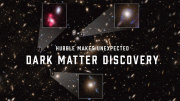

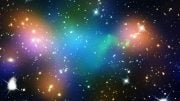
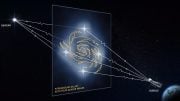
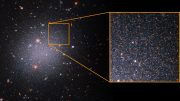
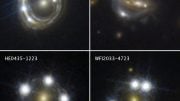
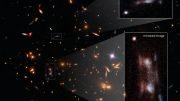

When you’re looking that far away, a lot of uncertainties can foul things up. And the computer simulations, as noted, may be missing stuff.
Another possibility, from a view of String Theory, is that Dark Matter appears to us as an effect of string/anti-string annihilations. As you may know, quantum mechanics requires that strings must be formed as pairs in the quantum foam – a string and an anti-string – that immediately annihilate each other. Quantum mechanics also requires both the string and anti-string to be surrounded by “jitters” that reduce their monstrous vibrating energies. What if this jitter remains for a fraction of an instant after their string/anti-string annihilations? This temporary jitter would be seen by us as matter for that instant before it too returns to the foam. That’s why we never see it – the “mass” lasts only for that instant but is repeated over and over and over, all over.
If this speculation is possible, then the quantum foam becomes more dense around more dense objects, such as galaxy clusters. Exciting physics awaits.
Specifics on the speculation can be found in my YouTube https://www.youtube.com/watch?v=N84yISQvGCk
What you have found is a image of God but an image not the whole picture ok lensing and we are about to be in heaven brothers and sisters….
Like an optical magnifier moved closer to the eye provides a larger image, maybe some patches of dark matter can be “closer” to our dimension therefore providing a greater influence on gravitational lensing.
This is Man’s condemnation. It is truly the sign of the TIME! Everything will move swiftly now as Mankind try to uncover the Mysteries of God’s Creation. God made man in the likeness of his image! not to be like God. Man can create Evil but can never control it.
May God have mercy on our Souls
Thats amazing that gravity can cause this bending of light around an object .here on earth we call that refraction and our atmosphere bends the light . light is bent because of the density of the atmosphere then thru the vaccume of space. It slows the speed of light. Same thing thru a glass of water but once thru it will continue on at the same angle and velocity . I am amazed gravity does what density also accomplished.
And the recent pictures of dark matter that scientist photo chopped looks suspiciously like the remains of a super nova but repeated over and over . People are incredible. Really i mean that . Incredable.
… yeah, it might be that the dark matter is a proof that it is a God, but what is the dark energy then…
That story makes more sense, then this article, … not that I say that article is not good, but the story of dark matter is bit…
Remember that dark matter and dark energy are called ‘dark’ simply because scientists cannot detect it directly. It does not emit any sort of electromagnetic radiation. The reference to darkness should not imply anything sinister. Instead, it could very well be the very substance of God.
What if the big bang theory was just God saying let there be light?
The so-called Big Bang was theorized because Hubble discovered that space is expanding. Reverse the process and we can imagine spacetime contracting to a singularity at the moment of creation 13.8 billion years ago. This could very well be the ‘let there be light’ moment.
Why are loonies always attracted to science articles? Is it because of a sense of inadequacy, knowing in the back of their minds that their god myths have no substance? Is it that desperation to hang on to the lies that have governed their lives that they look at any new discovery and twist their logic in to pretzels to incorporate it in to their mythology that drives them?
Notice that none of the loonies could be bothered to say which of the huge number of ‘gods’ mankind has invented they were talking about. It could be Jupiter or Thor or even any or all of the Shinto gods. Who knows?
If the Big Bang was the ‘let there be light’ moment then it cannot be the ‘gods’ described in the bible because that would prove that the bible was telling lies but they don’t seem to realise that simple fact.
I’d say the missing ‘ingredient’ is ‘charge.’ 😐
Who would I send a picture to? That I took in Kingman AZ 5/29/23
Hypothesis: Dark Matter is just ordinary matter displaced along a 4th spatial dimension that does not transmit electromagnetism/photons. At the Big Bang, as matter and antimatter condensed out of pure energy, much of the energy divided the matter and antimatter along this axis. Much of Dark Matter is the antimatter corresponding to our observable ordinary matter. The potential energy stored in this system is Dark Energy that is now being gradually released back into our universe, speeding expansion. If we can figure out how to reach into the displaced antimatter, we could have pure energy to drive civilization.
Because earth has been a gravity well for 4 billion years, it should have picked up a lot of Dark Matter. Because DM does not interact with ordinary matter, it would sink in toward the core. The rotation of the Dark Matter might be a factor in the occasional reversal of the magnetic poles of earth’s magnetic field, as it drags earth’s core by gravity. Since ordinary Metter is only 20% of mass in our universe, believing earth is 100% ordinary matter makes no sense. Earth could not repel Dark Matter, which is plentiful in our galaxy. There must be a significant quantum of it under our feet.
Very interesting LtCol Swenson. Please keep posting!
BettyL
I wonder if what the see could be the same principle as light refraction in glass due to to energy or the gravitational force distorting the path of the light to the lense
Gee whiz, where is “fixing gravity for you” when he/she is needed to bestow a sample of know-it-all-ism.